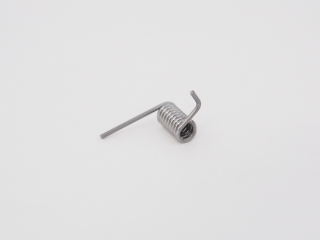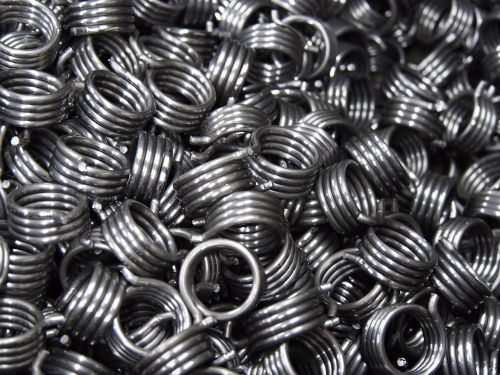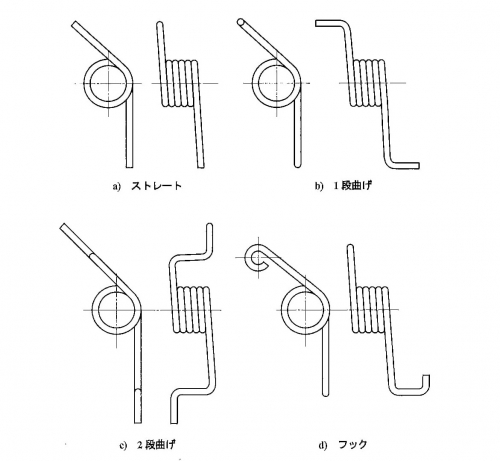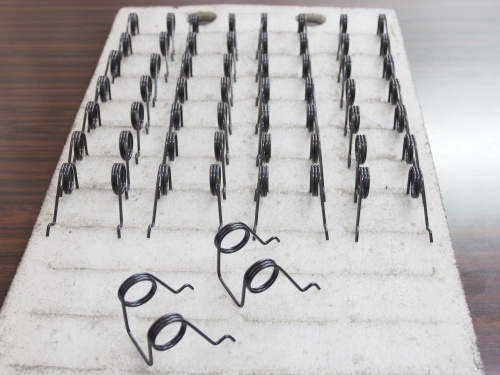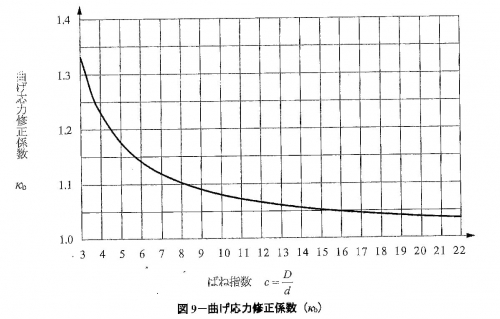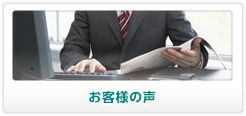TORSION COIL SPRING
|
We have summarized the basic points to note when designing torsion
Torsion coil spring design 7 points
Point 1 Shape of torsion coil spring
Typical shapes of torsion coil springs are as follows.
Example of manufacturing a short hook-shaped torsion spring
Spring for futon scissors
Example of manufacturing a double torsion shape torsion spring
Spring for automobile drive system
Point 2 Prerequisites for using the torsion spring formula
When using the formula for torsion springs, the following two conditions are premised.
If this condition is not met, the formula may be modified or unusable.
1. 1. About the direction to use the torsion spring
Torsion springs can be used in two directions as follows.
① When using in the direction in which the torsion spring is wound
② When using in the direction of rewinding the torsion spring
The formula for calculating the torsion spring is based on ①.
In case of ②, it is necessary to correct the basic calculation formula. See point 5 for a fix.
2. 2. The stress generated on the surface of the material outside the coil is uniform
Specifically, if ① the spring index is 3 or more and ② the number of turns is 3 or more, the stress generated on the surface will not be uniform.
Outside of this condition, as the spring is wound, the coil part will be displaced or tilted, and the stress will not be uniform.
Also, for oil tempered wires, it is reasonable to avoid using a spring index of 4 or less.
* Spring index = average diameter of coil of spring ÷ wire diameter
Point 3 The calculation formula changes depending on the length of the arm
There are two systems for calculating torsion springs.
① When you do not need to consider the length of your arm
② When it is necessary to consider the length of the arm
In what cases ① "do not consider" or ② "consider" becomes a problem.
The following formula is used to determine how to determine. If applicable, it will be ② "when it is necessary to consider".
Sum of effective lengths of arms ≧ 0.09 × pi × average coil diameter × number of turns of torsion spring
* Torsion springs usually have two arms, which are added.
Point 4 Use the longitudinal modulus
Use the "vertical" modulus to calculate the torsion spring.
Note that we do not use "lateral" modulus of elasticity like push springs and pull springs.
The modulus of longitudinal elasticity is as follows, depending on the type of material.
Hard steel wire, piano wire, oil tempered wire ... 2.06 x 10 5
Stainless steel wire for springs… 1.86 × 10 5 (However, SUS631 is 1.96 × 10 5 )
Brass wire… 0.98 × 10 5
White line… 1.08 × 10 5
Phosphor bronze wire… 0.98 × 10 5
Beryllium copper wire… 1.27 × 10 5
Point 5 Correction of bending stress of torsion coil springs
If you want to use it in the direction of rewinding the torsion spring, modify the basic formula.
Since the maximum bending stress is generated on the material surface inside the coil, it is necessary to consider the bending inside the coil.
Calculated using the bending stress factor according to the spring index.
First, the formula for calculating the maximum value of bending stress is as follows.
Maximum value of bending stress = {32 x (effective radius of action of arm + average coil diameter ÷ 2) x load x bending stress correction coefficient } ÷ (Pi x Wire diameter 3 )
Here, the bending stress correction factor becomes an issue. There are two ways to know this coefficient.
1. 1. How to read from the graph
Read the coefficients from the graph below. You can read "about" numbers.
* Spring index = coil average diameter ÷ wire diameter (c = D / d)
2. 2. How to calculate
If you want to get the numbers exactly, use the formula below to calculate. This method is the mainstream.
Bending stress correction coefficient = {4 x spring index 2 -spring index-1} ÷ {4 x spring index x (spring index-1)}
This formula is called "War's formula". Whirl is the name of a person.
There are other formulas that give the correction factor, such as "Bergstrasser's formula" and "Gener's formula".
JIS recommends using the above "War formula".
If you really want to use another formula (I don't think there is such a person), the parties must agree and use it.
Point 6 Diameter of the guide rod of the torsion spring
Twisting the torsion spring in the winding direction reduces the inner diameter of the coil.
The diameter of the guide rod should be 90% of the inner diameter of the coil at maximum use when the torsion spring is most engaged.
The formula is as follows.
Guide rod diameter = 0.9 x (coil inner diameter- change in coil average diameter )
Here, the problem is how to obtain the amount of change in the average coil diameter.
There are the following two calculation methods depending on how the angle is expressed.
1. 1. When the angle display is the arc degree method rad (radian)
Amount of change in coil average diameter = (maximum helix angle x coil average diameter) ÷ (2 x pi x number of turns)
2. 2. When the angle display is degree °
Amount of change in coil average diameter = (maximum helix angle x coil average diameter) ÷ (360 x number of turns)
Point 7 Spring characteristics of torsion springs
If you need to specify spring characteristics (if you write tolerances on the drawing), you need to note the following:
* Spring characteristics: Spring constant, specified load (push spring, pull spring), moment (torsion spring)
1. 1. For torsion springs, the spring characteristic is specified as the moment at the specified torsion angle. The unit is N ・ mm. Not specified by spring constant or load.
2. 2. Even with the same design, the spring characteristics will change if the following factors are different.
① Relationship between torsion spring and guide rod friction
② Attitude of torsion spring during operation
③ End shape of torsion spring
3. 3. When specifying spring characteristics, it depends on the agreement between the parties. In that case, there are two points to note.
① Designation conditions for spring characteristics (about the mounting position, guide rod, and other conditions in 2. above)
② About the measurement method
If you have any questions about the spring design, please feel free to contact us.
|
||
> YouTube channel [Spring comprehensive manufacturer "Fusehatsu Kogyo"] Video is being distributed!
Became an official sponsor of the professional basketball team
 |
メールアドレスはこちら
![]()




